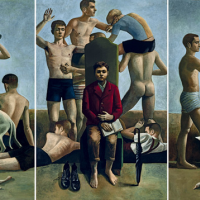86. ANNE WALLACE

The two-metre high, three-metre-wide triptych, Sour the Boiling Honey 1991, is the work that introduced Anne Wallace to the Australian art scene. Completed at the age of just twenty-one, the work is an ambitious, early example of Wallaces figurative painting and singular commitment to contemporary realism.
I wanted to create something so big in a way I couldn't back down from it.1
With three decades of practice to her credit, Wallace has been securing her name as a notable figure in Australias contemporary art world and has earned a reputation as one of Queenslands quintessential artists.2 Her work features in the collections of major Australian galleries, including the National Gallery of Victoria and the National Gallery of Australia as well as the Macquarie Bank Collection. In addition to her recent touring retrospective Strange Ways (2019-20), Wallace has also been included in prominent exhibitions such as Know My Name Australian Women Artists 1900 to Now (2020), National Gallery of Australia, with her work, She Is (2001), a painting noted in several publications.3
First displayed at Darren Knight Gallery, Sydney 1992, Sour the Boiling Honey had rarely been seen until Wallaces retrospective Strange Ways, where it enjoyed centre-stage as one of the exhibitions highlights.
The work depicts groupings of adolescent boys and girls by the sea inspired by Dylan Thomas 1934 poem I See the Boys of Summer. In sharp contrast to the sparsely dressed and nude figures enjoying each others company is the central androgynous figure, who is almost fully clothed and facing the viewer. This figure is thought to be Wallace, herself. The tension and isolation between the lone figure and the beach goers is palatable they seem to belong to different worlds.
Sour the Boiling Honey laid the foundation for Wallaces unique practice. In it, we can see elements that have since gone on to define her oeuvre: a strong reference to poetry and contemporary, popular source material, an overarching sense of tension, and representational images which curiously defy simple narrative readings.
The basis of my practice is about using clear representational imageryIm using that in a way that is deliberately not supplying straightforward meaning to create an experience that is part of life.4
Wallace enjoys the status of one of Australias great figurative painters alongside Jeffrey Smart (1921-2013).5 It is a style that is often associated with antiquated, unmodern art forms. And yet, artists like these demonstrate that style can not only be contemporary, but that it is also timeless.
FOOTNOTES
1. Anne Wallace, quoted in Moore, T., Brisbane Painter Anne Wallaces Strange Ways in their Final Days, Brisbane Times, 20 February 2020
2. Llewellyn, J., Anne Wallace: Real and Unreal, The Adelaide Review, issue 448, 28 September 2020
3. McDonald, J., A Spectacle Worth Seeing: Celebrating the Vitality of Women Artists, The Sydney Morning Herald, 7 January 2022; Higgie, J., A New Kind of History: `Know My Name, The Monthly, April 2022; Gaskin, S., National Gallery of Australia Launches `40:40:20; Gender Equity Plan, Ocula Magazine, 8 March 2022
4. Anne Wallace, quoted in Llewellyn, op. cit.
5. Wallace, A., From the Side of the Road Jeffrey Smart and Painting in Hart, D., and Edwards, R., Jeffrey Smart, edited by Armstrong, C., National Gallery of Australia, Canberra, 2021
Alice Evatt